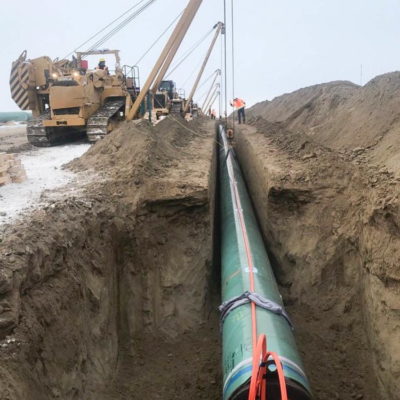So we had our inaugural Crude Observations Coffee on Tuesday and I think it went pretty well. There was a spirited and friendly conversation back and forth about the new federal support program for the energy industry among other topical matters.
One of the more satisfying aspects of it was just being able to connect with people from a broad variety of backgrounds and industries to actually have a conversation about what they were doing, what they were feeling and how they were managing and coping with this pandemic mess.
I encourage anyone who wants to participate to send me an email indicating this and I will send you a link that will allow you to join the Zoom call. Participation is voluntary and free, but you need to supply your own coffee.
At any rate, the purpose of this supplement is to present the summary of the support program we discussed and a couple of ideas that could help make it better.
The first part of the Federal support program that everyone already knows about is the headline funding for cleaning up orphaned and abandoned wells. This consists of the following:
- $1.7 billion to be allocated to cleaning and remediating orphaned and inactive wells across Western Canada
- $1 billion of this is allocated to Alberta
- Of this amount $200 million is going to the Orphan Well Association which deals with wells that have been abandoned by companies that have gone bankrupt or otherwise out of business. These wells number at least 5000 and could reach as high as 10,000. This cash is complementary to any amounts already allocated by respective provincial governments.
- The balance will go towards the approximately 85,000 inactive wells of differing age and legacy located across the Western Canadian Sedimentary Basin.
- This allocation of funds does three important things
- It gets a specific subsector of the energy services industry back to work and saves jobs
- It shores up balance sheets of producers by removing specific liabilities, perhaps allowing access to incremental credit.
- It supercharges a cleanup process that otherwise could be deferred indefinitely in an adverse commodity price environment.
The second part of the program was a little more nebulous, although still substantial and this was the allocation of $750 million for programs designed to cut methane emissions. These funds would be distributed as loans for research, solutions and/or implementation and are aligned with a mutual provincial and federal commitment to reduce methane emissions. Given that there already exists a large and active methane emission reduction ecosystem, these are welcome funds that will allow promising technology to get to the field faster.
The third part of the program is a series of credit stabilization and working capital enhancement initiatives from Export Development Corporation (EDC). There are four components to this.
- An enhanced International Trade Guarantee Program that provides two products. A Performance Security Guarantee from EDC to Canadian financial institutions which will allow increased access to working capital and Surety Reinsurance where EDC reinsures surety companies for the bonds they issue with respect to Canadian companies to support contractual obligations. This is most applicable to construction companies.
- An Export Guarantee Program which guarantees losses that may be incurred by Canadian financial institutions in relation to other loan facilities.
- Credit Insurance which will protect a Canadian exporter from losses due to non-payment from commercial buyers, which is basically insuring receivables.
- A new EDC Reserve Based Lending Guarantee for qualifying companies that will work as follows:
- The company will work with their financial institution to determine their spring 2020 Borrowing Base and an amount above which the FI would be willing to lend the Borrower and EDC would guarantee 25% to 75% of that amount for a period of 12 months.
- Amount would be capped at 100MM per borrower.
- Qualifying companies will need to be a maximum size of 100,000 boepd and meet other criteria around executive compensation, equity distributions, pre-crisis credit worthiness, ARO requirements and EDC environmental policies
The last piece of the support package (so far) is a longer-term capital oriented solution from BDC targeting Medium sized enterprises which are as yet undefined. That said, with the focus on producers with the EDC package, this appears to be more targeted and suitable for energy service and related businesses.
While the details are not final, the credit program is expected to provide loans of between $15 million to $60 million to qualifying businesses with such loans expected to have terms of up to 4 years. This program is meant to supplement that already existing working capital support available through the BCAP program.
In all, it’s actually a more substantial package than the media is representing it as but still has some holes, specifically:
- There is nothing here for the larger producers or that narrow band of producers who are larger than 100,000 boepd but don’t have the financial flexibility of a Suncor or CNRL
- None of these programs address the working capital crisis that is unfolding in the service sector as companies that were busy up until March now have bloated receivables balances that they are waiting on producers to pay as everyone hoards cash thus pushing the service companies further into crisis
Herewith I propose one simple solution for each:
- For cash-strapped or concerned intermediates and majors, the federal government should consider either the purchase or guarantee of certain debt instruments on a case by case basis. Why case by case? There aren’t that many companies.
- For working-capital starved service companies, the federal government should have EDC adapt its AR Credit Insurance program for domestic purposes to ensure that service companies who did work prior to and during the pandemic get paid for that work. Alternatively, they could make any federal support conditional on reducing and maintaining aged payables to 30 days or less, however this presupposes producers using the federal programs.
If you have any questions about the above programs or need assistance navigating the labyrinth to access any of these funds, please reach out to either one of us.
NFL Draft tomorrow – super exciting I know, but at least it’s a semblance of normal. And of course we know what that means. That’s right – a Crude Observations draft on Friday. Who will be the top pick? Who knows! Well I do, but you’ll have to wait.









